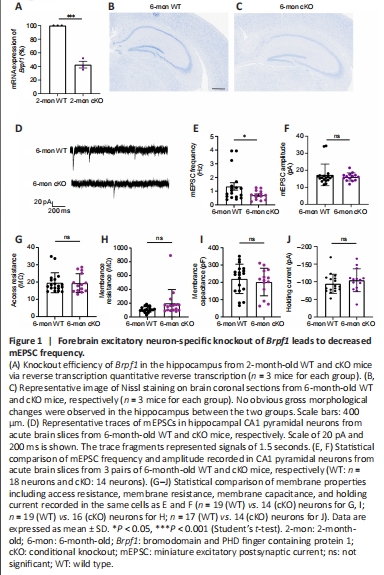脑损伤
-
Figure 1|Forebrain excitatory neuron-specific knockout of Brpf1 leads to decreased mEPSC frequency.

To determine the function of Brpf1 in the mouse postnatal forebrain, we mated Brpf1flx/flx mice with CaMKIIa-Cre mice, in which Cre recombinase is specifically expressed in the forebrain, especially in the CA1 pyramidal neurons of the hippocampus and layer V pyramidal neurons of the cerebral cortex, starting in the 3rd to 4th week postnatally (Mayford et al., 1996). The resulting Brpf1flx/+; CaMKIIa-Cre mice were grossly normal, and further intercrossing yielded Brpf1flx/flx; CaMKIIa-Cre (cKO) mice. The cKO mice were viable and the knockout efficiency in the hippocampus reached about 60% in 2-month-old mice (n = 3 pairs, P = 0.0003; Figure 1A). We obtained an expected Mendelian ratio for the survival of cKO mice into adulthood after genotyping about 210 offspring from Brpf1flx/+; CaMKIIa-Cre intercrosses, indicating no major postnatal lethality of forebrain excitatory neuron-specific knockout of Brpf1 (Table 1). We previously reported that acute 50% knockdown of Brpf1 did not affect neuronal morphology in primary cultured hippocampal neurons (Xian et al., 2021). Thus, we did not expect neuronal morphological changes in cKO mice at 2 months old, and so checked at a later stage, i.e., 6 months old. Gross histology examination revealed no major morphological abnormalities in the hippocampus or cerebral cortex in 6-month-old cKO mice via Nissl staining (n = 3 pairs; Figure 1B and C).
We previously reported a reduced excitatory synaptic transmission in primary cultured hippocampal neurons upon Brpf1 knockdown (Xian et al., 2021). To confirm this effect in the context of retained cytoarchitecture and synaptic circuits in vivo, we performed whole-cell patch-clamp recordings of CA1 pyramidal neurons in acute brain slices from 3 pairs of 6-month-old WT and cKO mice. We performed electrophysiological recordings on 6-month-old mice to determine whether the electrophysiological features had changed even if the gross morphological features were the same. We found that the frequency but not the amplitude of mEPSCs decreased significantly, suggesting that conditional deletion of Brpf1 in forebrain excitatory neurons impairs general spontaneous miniature excitatory transmission (representative traces, Figure 1D; mEPSC frequency and amplitude, n = 18 vs. 14 neurons from 3 mice each, P = 0.0369 for Figure 1E and P = 0.4733 for Figure1F). To exclude the influence of cell membrane properties, we examined basic membrane properties. Access resistance, membrane resistance, membrane capacitance, and holding currents were unchanged in cKO CA1 pyramidal cells compared with the control, indicating intact general membrane properties in these cells in cKO mice (n = 19 vs. 14 neurons from 3 mice each, P = 0.9070 and 0.3623 for Figure 1G and I, respectively; n = 19 vs. 16 neurons from 3 mice each, P = 0.0580 for Figure 1H; n = 17 vs. 14 neurons from 3 mice each, P = 0.5365 for Figure 1J).